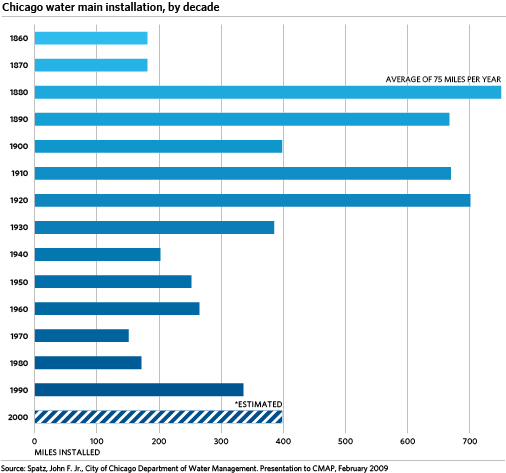Aging infrastructure is a major issue for U.S. cities and Chicago is no exception. Financing infrastructure improvements for drinking water and wastewater is a particularly challenging issue as aging underground pipes are essentially invisible to the public, especially when compared to above-ground assets such as transit and roads. Evidence of the gap between needed infrastructure investment and the actual level of investment undertaken abounds -- the 2010 American Society of Civil Engineer's Illinois Infrastructure Report Card cites an investment need of about $27 billion over the next 20 years, with $13.5 billion needed for drinking water systems and $13.4 billion needed for wastewater management systems. Closer to home, water utilities in the greater Chicago region have indicated that aging infrastructure and funding are two of their top three concerns in a 2008 survey conducted by CMAP. In an era of shrinking federal and state support for funding repairs, who will pay to ensure that water systems continue to meet our expectations for safe and reliable drinking water?
Public water suppliers must move towards rates that recover the full-costs of services delivered. CMAP's regional water supply/demand plan, Water 2050, created in concert with the Northeastern Illinois Regional Water Supply Group in 2010, brought much needed attention to the discussion of water rates and water-rate structures for full-cost pricing. Full-cost recovery involves "recouping the entire cost of water provision through rates, fees, charges, and other revenue derived from water sales," according to a definition set by the U.S. Environmental Protection Agency. Among the many recommendations made in Water 2050, one aimed at public water suppliers is to implement rate structures based on full-cost water price within a broader conservation program.
The City of Chicago serves 125 suburban communities in addition to its own residents for a total population served of over 5.4 million people living in five counties. The infrastructure serving this subregion is very old -- nearly 1,000 installed miles of water main pipelines are now at least 100 years old. During the last decade, the City replaced an average of 42 miles per year. While this saved a considerable amount of water, a benefit for the entire region both now and into the future, the maintenance rate is outpaced by the infrastructure-aging rate. With more than 2 million more people expected to call metropolitan Chicago home by midcentury, and regional water demand potentially growing by as much as 64 percent according to Water 2050, such a scenario is unsustainable.

The City of Chicago's recently proposed 2012 budget includes raising water and sewer rates to fund infrastructure improvements that would replace 900 miles of water pipes, reline 750 miles of sewer lines as well as 140,000 sewer catch basins, and would upgrade four aging, steam-powered pumping stations. The proposed water-rate hikes would move the City closer to full-cost pricing, and would fund much needed infrastructure improvements. Failing to make such improvements also costs money, as evidenced by a century-old water main break last week.